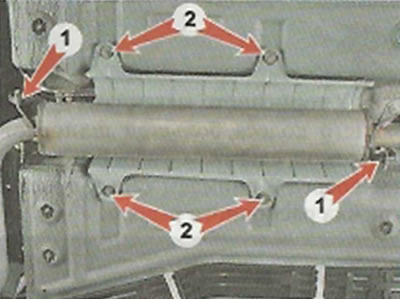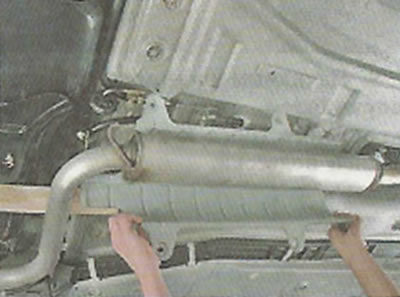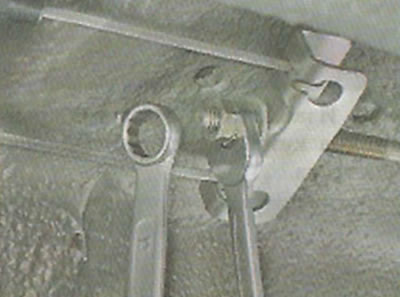Recommendation. If the lever travel is six clicks or more, adjust the parking brake actuator.
To complete the work, you will need a viewing hole or overpass.
Execution sequence
1. We prepare the car for work («Preparing the car for maintenance and repair»).
2. Raise the parking brake lever all the way up, determining the amount of its travel. If it is less than 2 clicks, lengthen the drive, and if more than 6, shorten it.
3. Fully lower the parking brake lever.
4. Remove the pillows from the brackets of the additional muffler 1 («Suspension of the exhaust system - replacing pillows»). Using a socket wrench, unscrew the four nuts 2 securing the protective screen.

5. Having pulled the additional muffler from the bottom of the car, we place a wooden block under the muffler pipe. We take out the protective screen.

6. While holding the adjusting nut from turning with a 13 mm open-end wrench, loosen the lock nut with a 13 mm spanner.

7. When unscrewing the adjusting nut, the drive lengthens, when tightened, it shortens.
8. Periodically, during the adjustment process, we check the stroke of the lever.
Note. If the length of the threaded part of the rod is not enough to adjust the stroke of the lever, it is necessary to replace the cables with water, and in case of severe wear of the linings and brake pads.
9. Having adjusted the stroke of the parking brake lever, we hang out the rear of the car. We check the ease of rotation of the rear wheels and the reliability of their fixation with the parking brake.
10. If the brake pads do not interfere with the rotation of the wheels, fix the adjusting nut with a locknut. Install the protective screen in place.
11. We check the performance of the parking brake system: on a slope with a slope of 23%, it should reliably hold the car stationary. If necessary, we check the condition of the parts of the parking brake drive, the condition of the rear brake shoes and brake drums. We replace defective and worn parts. Then we repeat the adjustment.
